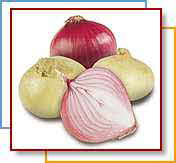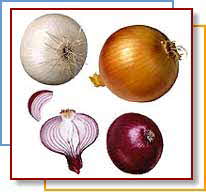Home | FOOD ARTICLES | Food Trivia | Today_in_Food_History | Food_History_Timeline | Recipes | Cooking_Tips | Food_Videos | Food_Quotes | Who’s_Who | Culinary_Schools_&_Tours | Food_Trivia_Quizzes | Food_Poems | Free_Magazines | Food_Festivals_and_Events
Food Articles, News & Features Section
FREE Magazines
and other Publications
Free Professional and Technical Research, White Papers, Case Studies, Magazines, and eBooks
ONIONS
Vegetables - See also: Onion Family; Onion Tears; Onion History; Onion Trivia; Kitchen Tips; New York Bold Onions; Vidalia Onions; Maui Onions;
Onion Quotes; Onions & Tears
The onion is believed to have originated in Asia, though it is likely that onions may have been growing wild on every continent. Dating back to 3500 BC, onions were one of the few foods that did not spoil during the winter months. Our ancestors must have recognized the vegetable's durability and began growing onions for food.
The onion became more than just food after arriving in Egypt. The ancient Egyptians worshipped the onion, believing that its spherical shape and concentric rings symbolized eternity. Of all the vegetables that had their images created from precious metals by Egyptian artists, only the onion was made out of gold. Today, onions are used in a variety of dishes and rank sixth among the world's leading vegetable crops. Onions are low in calories and in most nutrients (however, green onions are a good source of Vitamin A.)
Onions not only provide flavor; they also provide health-promoting phytochemicals as well as nutrients. Onions contain quercetin, a flavonoid (one category of antioxidant compounds), and allium.
Selection

Most onions are sold loose by the pound, although some types are sold in bags or small boxes. Look for onions that feel dry and solid all over, with no soft spots or sprouts. The neck should be tightly closed and the outer skin should have a crackly feel and a shiny appearance. Onions should smell mild, even if their flavor is not. Avoid selecting onions with green areas or dark patches.
Storage
Onions should be kept in a cool, dry open space away from bright light. Onions do best in an area that allows for air circulation. Because onions absorb moisture, do not store onions below the sink. Also, do not place onions near potatoes because potatoes give off moisture and produce a gas that causes onions to spoil more quickly. Spring/summer onions usually store for about two weeks and storage onions for about three to four weeks.
Varieties
Onions came in a variety of sizes, colors and shapes. They are often broken down into three categories: spring/summer, storage, and pearl onions.
Spring/summer onions are grown primarily from fall to spring in warm weather areas and have a soft flesh and a mild or sweet taste. These varieties are generally shipped right after harvesting.
Storage onions have a firm flesh, dry, crackly outer skins and have a pungent flavor. After a brief period of drying, these onions are stored for several months before shipping.
Pearl onions are often called white onions and are densely planted to make the onions smaller. There are no nutritional differences among these onion types.
Onions also come in three colors — yellow, red, and white. Approximately 88 percent of the onion crop is devoted to yellow onion production, with about 7 percent red onions and 5 percent white onions.

Yellow onions are full-flavored and are a reliable standby for cooking almost anything. Yellow onions turn a rich, dark brown when cooked and give French Onion Soup its tangy sweet flavor.
The Red onion, with its wonderful color, is a good choice for fresh uses or in grilling and char-broiling.
White onions are the traditional onion used in classic Mexican cuisine. They have a golden color and sweet flavor when sautéed.
Preparation
Onions may be eaten raw or cooked. Onions should be peeled before preparing, except when baking. Onions may be boiled, braised, baked, microwaved, or sautéed.
Make Onions Part of Your 5 A Day Plan
· Use raw or cooked onions to season stews, soups, tomato sauces or cooked vegetables.
· Small pearl onions make a great side dish when seasoned with thyme.
· Enjoy onions on their own stuffed and baked.
· Stuff onions with chopped vegetables and rice or bread crumbs.
· Add raw onions to salads or fresh vegetable trays.
· Include onions to add crunch and flavor to dressings, relishes, or sauces.
RELATED ARTICLES
Please feel free to link to any pages of FoodReference.com from your website.
For permission to use any of this content please E-mail: james@foodreference.com
All contents are copyright © 1990 - 2026 James T. Ehler and www.FoodReference.com unless otherwise noted. All rights reserved.
You may copy and use portions of this website for non-commercial, personal use only.
Any other use of these materials without prior written authorization is not very nice and violates the copyright.
Please take the time to request permission.

